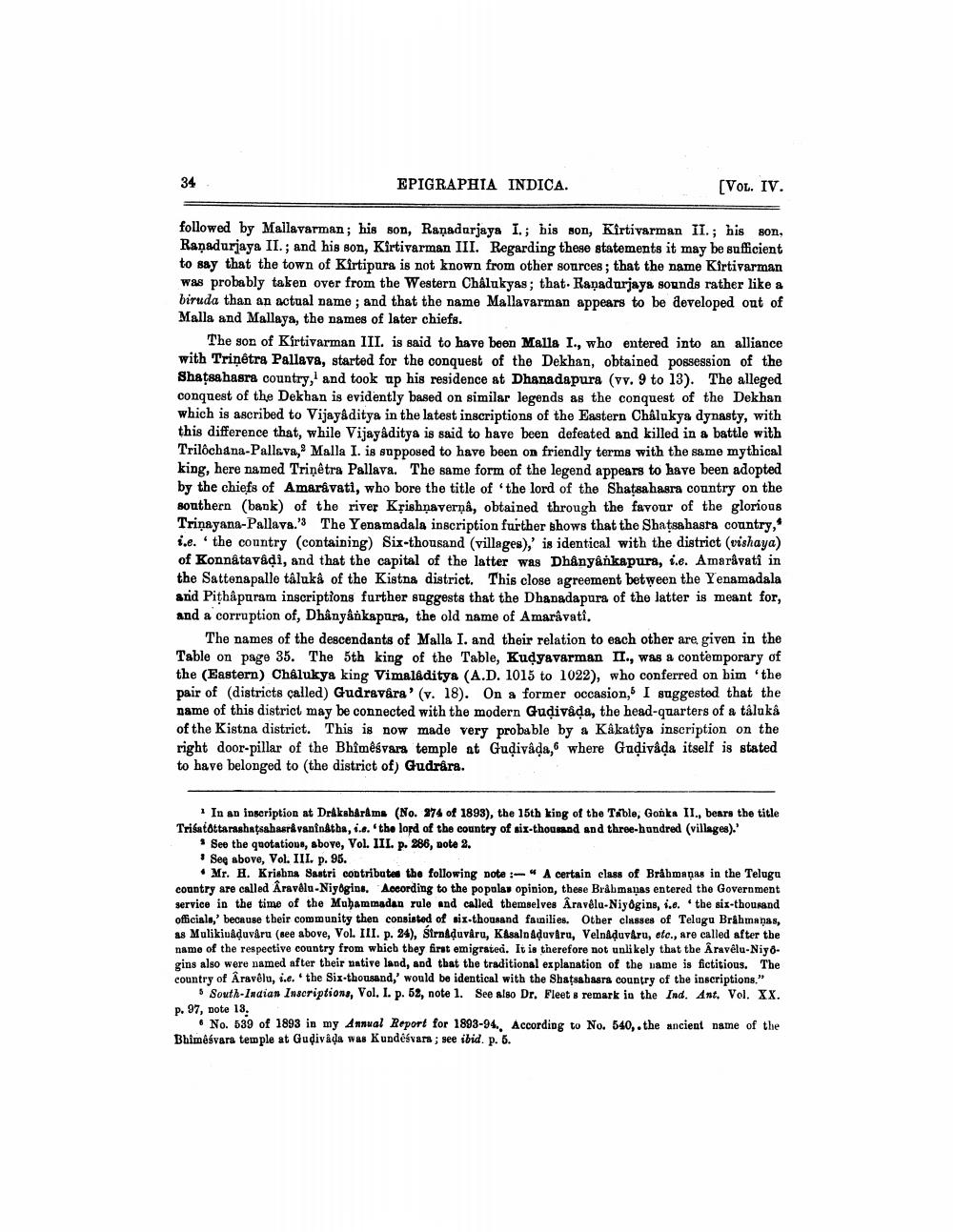________________
34
EPIGRAPHIA INDICA.
(VOL. IV.
followed by Mallavarman; his son, Ranadarjaya I.; bis son, Kirtivarman II.; his son, Raņadurjaya II.; and his son, Kirtivarman III. Regarding these statements it may be sufficient to say that the town of Kirtipura is not known from other sources; that the name Kirtivarman was probably taken over from the Western Châlukyas; that. Raņadurjaya sounds rather like a biruda than an actual name; and that the name Mallavarman appears to be developed out of Malla and Mallaya, the names of later chiefs.
The son of Kirtivarman III. is said to have been Malla I., who entered into an alliance with Triņêtra Pallava, started for the conquest of the Dekhan, obtained possession of the Shatsahasra country, and took up his residence at Dhanadapura (vv. 9 to 13). The alleged conquest of the Dekhan is evidently based on similar legends as the conquest of the Dekhan which is ascribed to Vijayaditya in the latest inscriptions of the Eastern Chalukya dynasty, with this difference that, while Vijayaditya is said to have been defeated and killed in a battle with Trilôchana-Palleva, Malla I. is supposed to have been on friendly terms with the same mythical king, here named Triņêtra Pallava. The same form of the legend appears to have been adopted by the chiefs of Amaravati, who bore the title of the lord of the Shatsahasra country on the southern (bank) of the river Krishnavernâ, obtained through the favour of the glorious Triņayana-Pallava.' The Yenamadala inscription further shows that the Shatsahasta country, i.e. the country containing) Six-thousand (villages),' is identical with the district (vishaya) of Konnatavadi, and that the capital of the latter was Dhânyankapura, .e. Amaråvati in the Sattenapalle tâluke of the Kistna district. This close agreement between the Yenamadala and Pithaparam inscriptions further suggests that the Dhanadapura of the latter is meant for, and a corruption of, Dhânyårkapura, the old name of Amaravati.
The names of the descendants of Malla I. and their relation to each other are given in the Table on page 35. The 5th king of the Table, Kudyavarman II., was a contemporary of the (Eastern) Chalukya king Vimaladitya (A.D. 1015 to 1022), who conferred on bim the pair of (districts called) Gudravåra' (v. 18). On a former occasion, I suggested that the name of this district may be connected with the modern Gudivada, the head-quarters of a taluka of the Kistna district. This is now made very probable by a Kakatiya inscription on the right door-pillar of the Bhîmêsvara temple at Gudivada, where Gudivada itself is stated to have belonged to the district of) Gudråra.
1 In an inscription at Drákshåráma (No. 374 of 1893), the 15th king of the Table, Gonka II., bears the title Trisntattarashasahasravaninatha, ... the lord of the country of six-thousand and three-hundred (villages).'
See the quotations, above, Vol. III. p. 286, bote 2.
See above, Vol. III. p. 95.
• Mr. H. Krishna Sastri contributes the following note :-"A certain class of Brahmaņas in the Telugu country are called Aravelu-Niyogins. According to the populas opinion, these Bråbmanas entered the Government service in the time of the Muhammadan rule and called themselves Áravêla-Niyôgins, i.e. the six-thousand officiale, because their community then consisted of six-thousand families. Other classes of Telaga Brahmaņas, as Mulikivadavåru (see above, Vol. III. p. 24), Sirniduvaru, Kasalo Aduvaru, Velnaduvaru, etc., are called after the name of the respective country from whicb they first emigrated. It is therefore not unlikely that the Aravēlu-Niyogins also were named after their antive land, and that the traditional explanation of the name is fictitious. The country of Aravēlu, i.e. the Six-thousand,' would be identical with the Shatabara country of the inscriptions."
South Indian Inscriptions, Vol. I. p. 52, note 1. See also Dr. Fleet & remark in the Ind. Ant. Vol. XX. p. 97, note 18.
No. 539 of 1893 in my Annual Report for 1893-94. According to No. 540,. the ancient name of the Bhimêsvara temple at Gudivada was Kundesvara; see ibid. p. 5.




